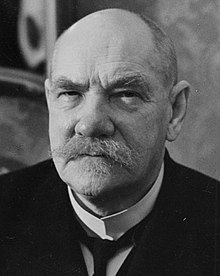
Back بير إفيند سفينهوفد Arabic بير افيند سفينهوفد ARZ Pehr Evind Svinhufvud AST Пер Эвінд Свінхувуд Byelorussian Пэр Эвінд Сьвінгувуд BE-X-OLD Pehr Evind Svinhufvud Czech Pehr Evind Svinhufvud Danish Pehr Evind Svinhufvud German Pehr Evind Svinhufvud Esperanto Pehr Evind Svinhufvud Spanish
Pehr Evind Svinhufvud | |
|---|---|
 Pehr Evind Svinhufvud during the Interwar Years | |
| 3rd President of Finland | |
| In office 2 March 1931 – 1 March 1937 | |
| Prime Minister | Juho Sunila Toivo Mikael Kivimäki Kyösti Kallio |
| Preceded by | Lauri Kristian Relander |
| Succeeded by | Kyösti Kallio |
| Prime Minister of Finland | |
| In office 4 July 1930 – 18 February 1931 | |
| President | Lauri Kristian Relander |
| Preceded by | Kyösti Kallio |
| Succeeded by | Juho Sunila |
| In office 27 November 1917 – 27 May 1918 | |
| Preceded by | Position established |
| Succeeded by | Juho Kusti Paasikivi |
| Regent of Finland | |
| In office 18 May 1918 – 12 December 1918 | |
| Preceded by | Position established |
| Succeeded by | Gustaf Mannerheim |
| Chairman of the Senate of Finland | |
| In office 27 November 1917 – 27 May 1918 | |
| Preceded by | Eemil Nestor Setälä |
| Succeeded by | Juho Kusti Paasikivi |
| Personal details | |
| Born | Pehr Evind Svinhufvud af Qvalstad 15 December 1861 Sääksmäki, Grand Duchy of Finland |
| Died | 29 February 1944 (aged 82) Luumäki, Republic of Finland |
| Political party | Young Finnish Party (before 1918) National Coalition Party (after 1918) |
| Spouse | Ellen Timgren |
| Children | Pehr Yngve, Ilmo Gretel, Aino Mary Alfthan, Eino Gustaf, Arne Bertel and Veikko Eivind |
| Alma mater | Imperial Alexander University (now University of Helsinki) |
| Occupation | Lawyer, Judge |
| Signature | |
| Nickname | Ukko-Pekka |
Pehr Evind Svinhufvud af Qvalstad (Finland Swedish: [ˈpæːr ˈeːʋin(d) ˈsviːnhʉːʋʉd ɑːv kʋɑːlstɑːd], 15 December 1861 – 29 February 1944) was the third president of Finland from 1931 to 1937. Serving as a lawyer, judge, and politician in the Grand Duchy of Finland, which was at that time an autonomous state under the Russian Empire’s rule, Svinhufvud played a major role in the movement for Finnish independence. He was the one who presented the Declaration of Independence to the Parliament.[1]
From December 1917, Svinhufvud was the first head of government of independent Finland as Chairman of the Senate.[1] He led the White government during the Finnish Civil War while Mannerheim led their armies. After the war, he served as Finland's first temporary head of state with the title of Regent during the project to establish a German-aligned monarchy in the country, until late 1918 when he stepped down in favour of Mannerheim. He later served as Prime Minister from 1930 to 1931,[2][3] before being elected to the presidency. As president, he was notable for putting an end to the Mäntsälä rebellion.
As a conservative and nationalist who was strong in his opposition to communism and the Left in general, Svinhufvud did not become a President embraced by all the people, although as the amiable Ukko-Pekka ("Old Man Pekka"), he did enjoy wide popularity.[4] Svinhufvud's sharp line as a defender of Finland's legal rights during the period under Russian rule was especially valued in the early years of independence until the end of the World War II, unlike in later decades. Ever since communism and the Soviet Union collapsed in the early 1990s, appreciation of Svinhufvud has begun to increase.[5]
- ^ a b "Tiistaina 4. p. joulukuuta – Hallituksen puheenjohtajan lausunto Suomen valtiollisen itsenäisyyden toteuttamisesta". Toiset valtiopäivät 1917, Pöytäkirjat, osa I (in Finnish). Valtioneuvoston kirjapaino. 1918. pp. 310–311.
- ^ "Ministerikortisto". Valtioneuvosto. Archived from the original on 2009-05-03.
- ^ "Edustajamatrikkeli". Eduskunta. Archived from the original on 2012-02-12.
- ^ Kotkaniemen tiluksilla vaalitaan presidentti Svinhufvudin perintöä (in Finnish)
- ^ Svinhufvud, Pehr Evind (1861–1944) (in Finnish)